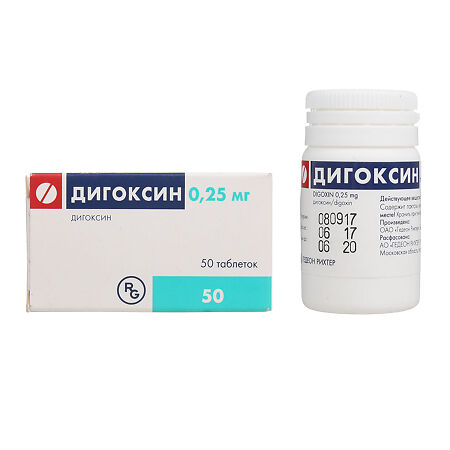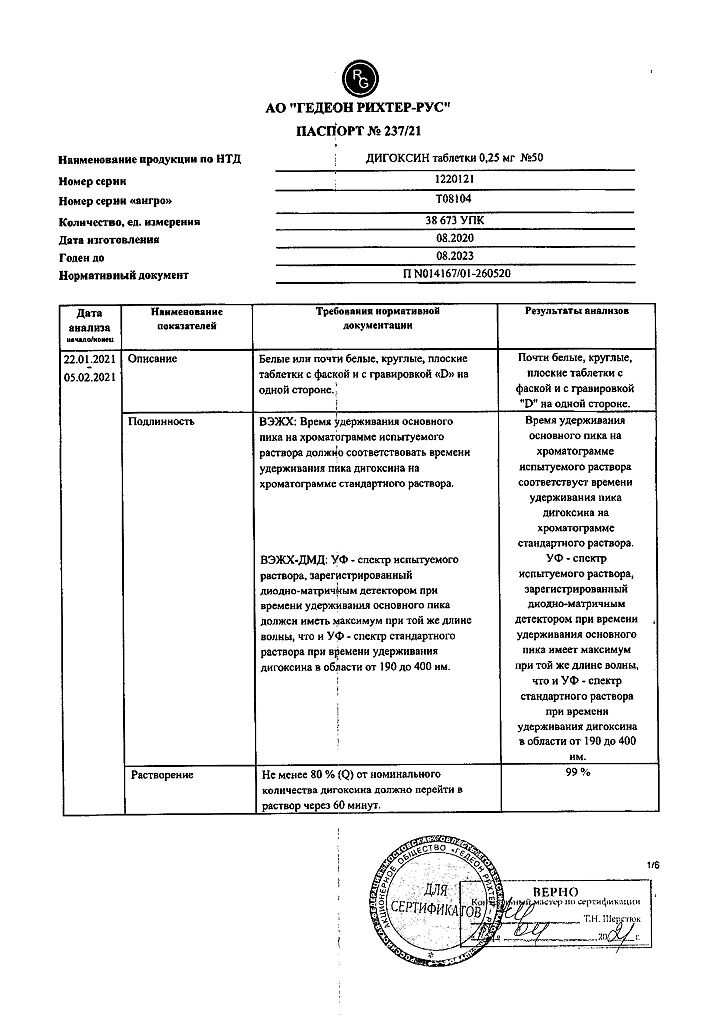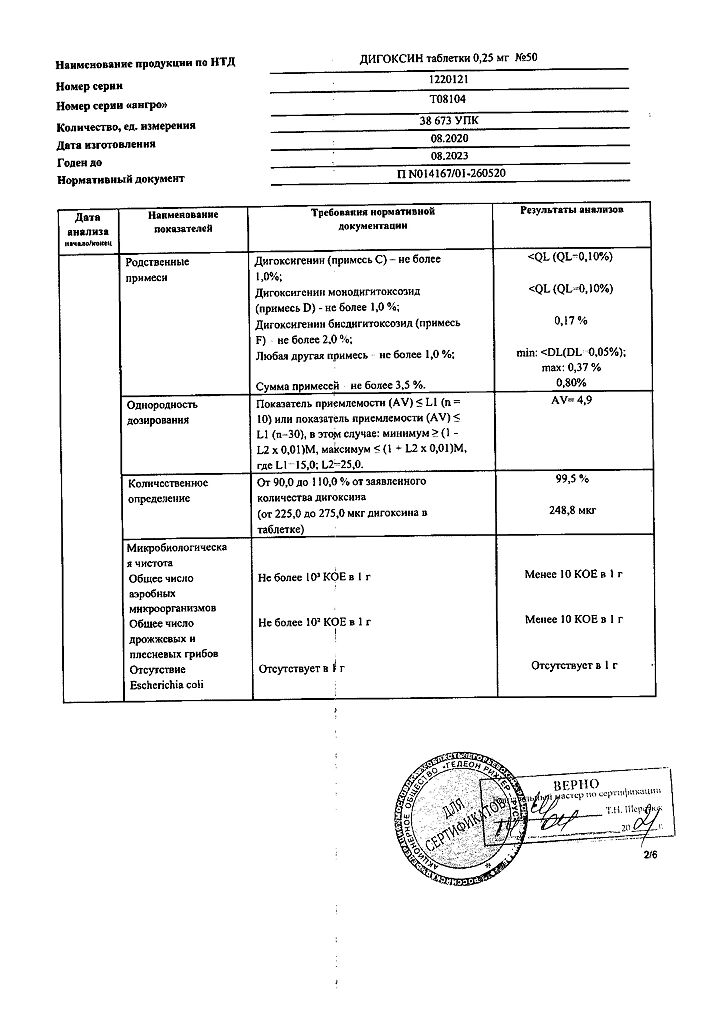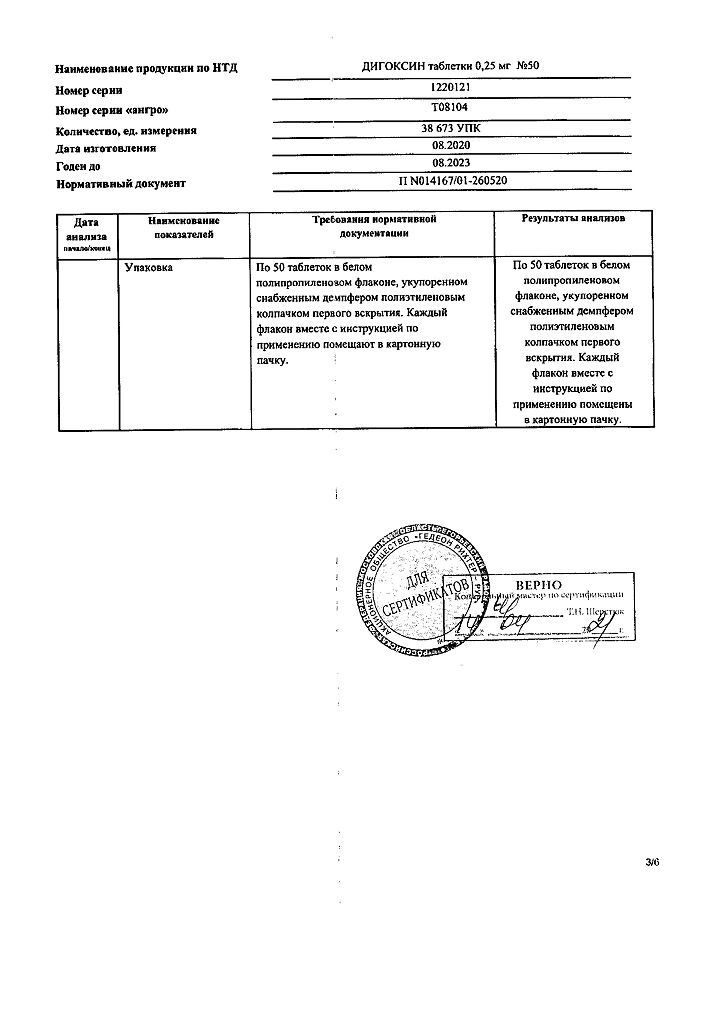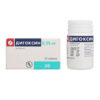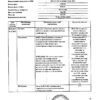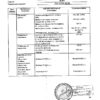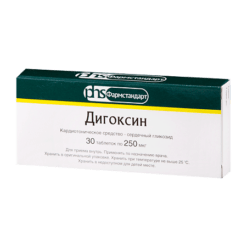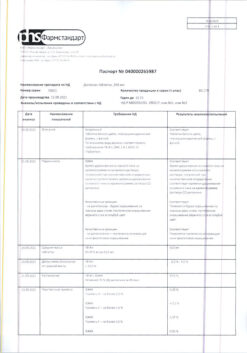No products in the cart.
Digoxin, tablets 0.25 mg 50 pcs
€3.12 €2.60
Description
Heart failure, Arrhythmia, Edema, Shortness of breath
Indications
Indications
as part of complex therapy of chronic heart failure II (in the presence of clinical manifestations) and III-IV functional class;
tachysystolic form of atrial fibrillation and atrial flutter of paroxysmal and chronic course (especially in combination with chronic heart failure).
Pharmacological effect
Pharmacological effect
Pharmacotherapeutic group: Drugs for the treatment of heart diseases; cardiac glycosides; Digitalis glycosides
Pharmacological action
Digoxin is a cardiac glycoside. It has a positive inotropic effect due to the direct inhibitory effect of sodium-potassium ATPase of cardiomyocyte membranes, which leads to an increase in the intracellular content of sodium ions and, accordingly, a decrease in potassium ions. The increased content of sodium ions causes activation of sodium-calcium metabolism, an increase in the content of calcium ions, as a result of which the force of myocardial contraction increases. As a result of increased myocardial contractility, the stroke volume of blood increases. The end-systolic and end-diastolic volumes of the heart decrease, which, along with an increase in myocardial tone, leads to a reduction in its size and, thus, to a decrease in myocardial oxygen demand.
It has a negative chronotropic effect, reduces excessive sympathetic activity by increasing the sensitivity of cardiopulmonary baroreceptors. Due to the increase in the activity of the vagus nerve, it has an antiarrhythmic effect due to a decrease in the speed of impulses through the atrioventricular node and a lengthening of the effective refractory period. This effect occurs as a result of an indirect effect on the AV node.
The negative dromotropic effect manifests itself in an increase in the refractoriness of the AV node, which allows the use of digoxin for paroxysms of supraventricular tachycardias and tachyarrhythmias. In case of atrial fibrillation, it helps to slow down the frequency of ventricular contractions, lengthens diastole, and improves intracardiac and systemic hemodynamics. A positive bathmotropic effect occurs when subtoxic and toxic doses are used.
It has a direct vasoconstrictor effect, which is most clearly manifested in the absence of congestive peripheral edema.
At the same time, the indirect vasodilating effect (in response to an increase in minute blood volume and a decrease in excessive sympathetic stimulation of vascular tone), as a rule, prevails over the direct vasoconstrictor effect, resulting in a decrease in peripheral vascular resistance.
Pharmacokinetics
Suction
Absorption of digoxin from the gastrointestinal tract is variable, accounting for 70-80% of the dose and depending on the motility of the gastrointestinal tract, dosage form, concomitant food intake, and interactions with other drugs. Bioavailability 60-80%. With normal gastric acidity, a small amount of digoxin is destroyed; in hyperacid conditions, a larger amount may be destroyed. For complete absorption, sufficient exposure in the intestine is required: with a decrease in gastrointestinal motility, bioavailability is maximum, with increased peristalsis it is minimal.
Distribution
The ability of digoxin to accumulate in tissues (cumulate) explains the lack of correlation at the beginning of treatment between the severity of the pharmacodynamic effect and its concentration in the blood plasma. Plasma protein binding is 25%. Apparent Vd – 5 l/kg.
Metabolism
Metabolized in the liver.
Removal
It is excreted mainly by the kidneys (60-80% unchanged), T1/2 is about 40 hours (determined by renal function). The intensity of renal excretion is determined by the amount of glomerular filtration. In mild chronic renal failure, the decrease in renal excretion of digoxin is compensated by hepatic metabolism to inactive compounds. In case of liver failure, compensation occurs due to increased renal excretion of digoxin.
Special instructions
Special instructions
Patients with chronic heart failure: Digoxin should be used in small doses – up to 0.25 mg/day; for patients weighing more than 85 kg up to 0.375 mg/day.
Patients with impaired renal function: the dose of digoxin should be reduced. With a CC value of 50-80 ml/min, the average maintenance dose is 50% of the average maintenance dose for patients with normal renal function, with a CC value of less than 10 ml/min – 25%.
Elderly patients: the daily dose of digoxin should be reduced to 0.0625-0.125 mg (1/4 – 1/2 tablet).
Children aged 3 to 10 years: saturating dose is 0.05-0.08 mg/kg/day; this dose is prescribed for 3-5 days with moderately rapid digitalization or for 6-7 days with slow digitalization. The maintenance dose for children is 0.01-0.025 mg/kg/day.
In case of acute myocardial infarction or severe lung diseases, exceptional precautions are required, because such patients have an increased sensitivity to arrhythmias, the development of which can be provoked by treatment with digitalis preparations.
In case of hypersensitivity of the carotid sinus or carotid sinus, digoxin should be used only after implantation of a pacemaker, since in such cases digitalis preparations can cause severe sinus bradycardia or sinoatrial block.
Digoxin should be avoided or used with extreme caution in patients with cardiac amyloidosis. Digoxin binds to amyloid, so digoxin toxicity may occur.
Hypoxia (against the background of severe lung or heart disease) increases the sensitivity of the myocardium to digitalis preparations.
Digoxin treatment should be discontinued two days before planned electrical cardioversion; otherwise, treatment-resistant ventricular fibrillation may develop. If there is an urgent need for electrical cardioversion in patients taking cardiac glycosides, it is recommended to use low voltages.
In patients receiving digitalis preparations, an exercise tolerance test may reveal false ST segment and T wave changes.
Sinus tachycardia is not an indication for the use of digoxin unless it is associated with heart failure.
Digitalis preparations are less effective in hypersystolic heart failure (ie, heart failure caused by arteriovenous anastomoses, anemia, infection, or hyperthyroidism).
Atrial arrhythmias caused by hyperthyroidism are usually resistant to digitalis treatment, whereas hypothyroidism usually requires lower doses of digoxin.
Hypercalcemia, hypokalemia, hypomagnesemia can contribute to intoxication with digitalis preparations, therefore, before treatment with digoxin, the content of these electrolytes should be normalized.
Digoxin may not be effective for hypocalcemia.
As one of the methods for monitoring the level of digitalization when prescribing cardiac glycosides, monitoring their concentration in blood plasma is used. Monitoring of renal function is also recommended in patients on long-term therapy with digitalis.
This drug should not be taken by patients with rare hereditary diseases such as galactose intolerance, lactase deficiency or glucose-galactose malabsorption.
Impact on the ability to drive vehicles and machinery
Studies assessing the effect of digoxin on the ability to drive vehicles and operate machinery that require increased concentration and speed of psychomotor reactions are insufficient, but caution should be exercised.
Active ingredient
Active ingredient
Digoxin
Composition
Composition
Active substance: digoxin
Excipients: colloidal silicon dioxide anhydrous, magnesium stearate, gelatin, talc, corn starch, lactose monohydrate.
Pregnancy
Pregnancy
Pregnancy
Digitalis preparations penetrate the placental barrier. Digoxin is classified as category C for safety during pregnancy. Studies in pregnant women are insufficient. Prescribing the drug is possible only if the expected benefit to the mother outweighs the potential risk to the fetus.
Breastfeeding period
Digoxin is excreted into breast milk. Since there is no data on the effect of the drug on infants, if therapy is necessary during this period, it is recommended to stop breastfeeding.
Contraindications
Contraindications
hypersensitivity to digoxin or to any of the excipients;
glycoside intoxication;
Wolff-Parkinson-White syndrome;
2nd degree AV block;
ventricular tachycardia and ventricular fibrillation;
intermittent complete blockade;
children under 3 years of age;
patients with rare hereditary diseases: lactose intolerance, fructose intolerance, lactase deficiency, sucrase/isomaltase deficiency or glucose-galactose malabsorption.
With caution
AV blockade of the first degree, indications of a history of Morgagni-Adams-Stokes attacks, ventricular extrasystole, increased sensitivity of the carotid sinus, SSSS, bradycardia; acute myocardial infarction, unstable angina; severe lung diseases, hypoxia (including hypoxia due to severe lung and heart diseases); heart failure with high cardiac output (arteriovenous shunt, anemia, infectious diseases, hyperthyroidism); hypertrophic obstructive cardiomyopathy in combination with atrial fibrillation and chronic heart failure; disorders of diastolic function (restrictive cardiomyopathy, cardiac amyloidosis, cardiac tamponade); pronounced dilatation of the heart cavities, “pulmonary” heart; chronic constrictive pericarditis, myocarditis; when performing electrical cardioversion; hypothyroidism; electrolyte disturbances (hypokalemia, hypomagnesemia, hypercalcemia, hypocalcemia); renal and liver failure; pregnancy, old age.
Interaction
Interaction
Concomitantly prescribed drugs may affect tissue sensitivity to digitalis, the extent of intestinal absorption, distribution, plasma and tissue protein binding, and renal excretion of digoxin. Because digoxin has a narrow therapeutic range, determination of serum digoxin concentrations is recommended in the event of possible drug interactions.
When digoxin is co-administered with drugs that cause electrolyte imbalance, in particular hypokalemia and hypomagnesemia (for example, corticosteroids, loop (for example, furosemide) and thiazide diuretics (for example, hydrochlorothiazide, indapamide), laxatives, amphotericin B, beta2-agonists (for example, salbutamol)), may increase toxic effects of digoxin. Before digitalization begins, it is necessary to normalize the potassium content in the blood serum.
Calcium, especially when administered intravenously, can cause severe arrhythmias in patients taking digitalis preparations.
Quinidine, calcium channel blockers (eg, nifedipine, diltiazem), beta blockers (eg, carvedilol), amiodarone, propafenone, atorvastatin, flecainide, NSAIDs (eg, indomethacin, diclofenac, ibuprofen), antifungals (eg, itraconazole), antiplatelet agents (eg, ticagrelor), inhibitors proton pump therapy (eg, rabeprazole, omeprazole, esomeprazole, lansoprazole), anxiolytics (eg, alprazolam), and some antibiotics (eg, erythromycin, tetracycline, azithromycin, trimethoprim) may increase serum concentrations of digoxin due to increased absorption from the gastrointestinal tract in patients taking cardiac glycosides, thereby increasing the risk intoxication.
Cardiovascular drugs
ACE inhibitors and angiotensin II receptor antagonists can cause hyperkalemia, which can reduce the binding of digoxin to tissues and lead to increased digoxin levels in the blood. These drugs may lead to the development of renal failure and increased plasma concentrations of digoxin due to decreased renal excretion. When taken concomitantly with captopril, an increase in the concentration of digoxin in the blood plasma is possible, but this is of clinical significance only in patients with impaired renal function or severe congestive heart failure.
Taking telmisartan causes an increase in the concentration of digoxin in the blood plasma, therefore, when taking these drugs simultaneously, careful monitoring of the patient’s condition is necessary.
In studies of clinically significant interactions between digoxin and other ACE inhibitors or angiotensin II receptor antagonists (cilazapril, enalapril, imidapril, lisinopril, moexipril, perindopril, quinapril, ramipril, spirapril and trandolapril; candesartan, eprosartan, irbesartan, losartan and valsartan) found, but monitoring of effects of concomitant use is warranted for safety reasons.
Nitroprusside and hydralazine increase the renal clearance of digoxin by increasing renal blood flow and tubular secretion, reducing plasma digoxin concentrations.
Concomitant use of digoxin with beta-blockers (including sotalol) or calcium channel blockers increases the risk of proarrhythmic events and may precipitate cardiac arrest, since these drugs have additive effects on the AV node.
Concomitant use of digoxin with sympathomimetics increases the incidence of ventricular arrhythmias, since both drugs increase ectopic pacemaker activity.
Concomitant use of digoxin with ivabradine may increase the risk of bradycardia.
Drugs that increase serum potassium (eg, spironolactone, amiloride, triamterene, potassium salts, succinylcholine) may cause arrhythmia.
Phenytoin may decrease the steady-state concentration of digoxin.
Inducers of microsomal oxidation (barbiturates, phenylbutazone, phenytoin, rifampicin, carbamazepine, primidone, topiramate, oral contraceptives) can stimulate the metabolism of digoxin (if they are withdrawn, digitalis intoxication is possible).
Antacids, kaolin/pectin, sulfasalazine, some laxatives, neomycin, cholestyramine, some antineoplastic drugs, metoclopramide reduce the absorption of digoxin and may cause digoxin to fail.
Due to a decrease in intestinal motility, propantheline and diphenoxylate increase the absorption of digoxin, as a result of which digitalis intoxication may develop.
P-glycoprotein inhibitors
Digoxin is a P-glycoprotein substrate. Therefore, P-glycoprotein inhibitors (such as verapamil, cyclosporine, antifungals (eg, isavuconazole, ketoconazole), antivirals (eg, ritonavir, telaprevir, saquinavir), antianginal drugs (ranolazine)) may increase the blood concentration of digoxin by increasing its absorption and/or by decreasing its renal clearance.
Isavuconazole may increase the systemic exposure of drugs that are P-glycoprotein substrates. When co-administered with isavuconazole, dosage adjustments may be required for drugs that are P-glycoprotein substrates, especially if they have a narrow therapeutic range, such as digoxin. Co-administration with isavuconazole leads to an increase in the average AUC to 125% and its average Cmax to 133%. The concentration of digoxin in the blood serum should be periodically determined and the data obtained should be used to titrate the dose of the drug. No dosage adjustment of isavuconazole is required.
When thyroid hormones are prescribed, metabolism increases, which may require an increase in the dose of digoxin.
Drugs that significantly increase serum digoxin concentrations (by more than 50%): amiodarone, captopril, dronedarone, erythromycin, itraconazole, propafenone, quinidine, ranolazine, ritonavir, telaprevir, tetracycline, verapamil – serum digoxin concentrations should be measured before using concomitant therapy. The dose of digoxin should be reduced when used simultaneously by 30-50%, while continuing to monitor the level of digoxin in the blood plasma.
Drugs that moderately increase serum digoxin concentrations (by less than 50%): atorvastatin, carvedilol, diltiazem, indomethacin, isavuconazole, nifedipine, propantheline, quinidine, rabeprazole, saquinavir, spironolactone, telmisartan, ticagrelor, trimethoprim – serum digoxin concentrations should be measured before use concomitant therapy. Reduce digoxin dose by approximately 15-30% and continue monitoring.
Drugs that increase the concentration of digoxin in the blood serum (the degree of influence has not been established): alprazolam, azithromycin, cyclosporine, diclofenac, diphenoxylate, epoprostenol, esomeprazole, ibuprofen, ketoconazole, lansoprazole, metformin, omeprazole – measure serum digoxin concentrations before using concomitant drugs. If necessary, reduce the dose of digoxin and continue monitoring.
Drugs that reduce the concentration of digoxin in the blood serum:
anticancer drugs: doxorubicin, methotrexate, vincristine or radiation therapy;
inducers of drug metabolism: barbiturates, phenytoin, rifampicin;
drugs for the treatment of gastrointestinal diseases: antacids, activated carbon, kaolin pectin, metoclopramide, neomycin, resins (colestyramine), sulfasalazine, sucralfate;
drugs that cause hypokalemia: amphotericin B, selective β2-adrenergic receptor agonists (albuterol, salbutamol, terbutaline), corticosteroids, laxatives;
muscle relaxants: succinylcholine (suxamethonium);
peripheral vasodilators: hydralazine, nitroprusside;
antidiabetic drugs: exenatide, miglitol, acarbose;
antidepressants: preparations of St. John’s wort (Hypericum perforatum);
other drugs: penicillamine;
eating foods high in bran.
When concomitantly using digoxin with drugs that reduce its concentration in the blood, it is necessary to measure serum digoxin concentrations before using concomitant drugs. Increase digoxin dose by 20-40% if necessary and continue monitoring.
Overdose
Overdose
Symptoms: loss of appetite, nausea, vomiting, diarrhea, abdominal pain, intestinal necrosis; ventricular paroxysmal tachycardia, ventricular extrasystole (often polytopic or bigeminy), nodal tachycardia, sinoatrial block, atrial fibrillation and flutter, AV block, drowsiness, confusion, delirious psychosis, decreased visual acuity, coloring of visible objects in a yellow-green color, flickering “floaters” before the eyes, perception of objects in a reduced or enlarged view; neuritis, radiculitis, manic-depressive syndrome, paresthesia.
Treatment: withdrawal of digoxin, intake of activated charcoal (to reduce absorption), administration of antidotes (sodium dimercaptopropanesulfonate, sodium edetate (EDTA), symptomatic therapy. Carry out constant ECG monitoring.
In cases of hypokalemia, potassium salts are used: 0.5-1 g of potassium chloride is dissolved in water and taken several times a day up to a total dose of 3-6 g (40-80 mEq K+) for adults, provided that renal function is adequate. In emergency cases, intravenous drip administration of 2% or 4% potassium chloride solution is indicated. The daily dose is 40-80 mEq K+ (diluted to a concentration of 40 mEq K+ per 500 ml). The recommended rate of administration should not exceed 20 mEq/h (under ECG monitoring). For hypomagnesemia, intravenous administration of magnesium salts is recommended. In cases of ventricular tachyarrhythmia, slow intravenous administration of lidocaine is indicated. In patients with normal cardiac and renal function, slow intravenous administration (over 2-4 minutes) of lidocaine at an initial dose of 1-2 mg/kg body weight, followed by drip administration at a rate of 1-2 mg/min, is usually effective. In patients with impaired renal and/or cardiac function, the dose should be reduced accordingly.
The use of atropine is indicated for the treatment of bradyarrhythmias and AV block. In case of II-III degree AV block, asystole and suppression of sinus node activity, installation of an artificial pacemaker is indicated, and lidocaine and potassium salts should not be prescribed until it is installed.
During treatment, it is necessary to monitor the calcium and phosphorus levels in the blood and daily urine.
There is experience with the use of the following drugs with possible positive effects: beta-blockers, procainamide, bretylium tosylate and phenytoin. Cardioversion may precipitate ventricular fibrillation.
Manufacturer
Manufacturer
Gedeon Richter, Hungary
Additional information
| Manufacturer | Gedeon Richter, Hungary |
|---|---|
| Medication form | pills |
| Brand | Gedeon Richter |
Other forms…
Related products
Buy Digoxin, tablets 0.25 mg 50 pcs with delivery to USA, UK, Europe and over 120 other countries.

